Influence of Urban Railway Network Centrality on Residential Property Values in Bangkok
Abstract
:1. Introduction
2. Literature Reviews
2.1. Influences of Urban Railways on Property Value
2.2. Influence of Network Centrality on Property Value
2.3. Hedonic Price Model
2.4. Regression Model with Spatial Effects
3. Methods
3.1. Network Centrality Measures
3.2. Hedonic Regression Models
- OLS model
- 2.
- Spatial lag model
- 3.
- Spatial error model
4. Network Centrality Analysis
4.1. Urban Railway Network in Bangkok
4.2. Network Centrality Results
- 4.
- Closeness centrality
- 5.
- Betweenness centrality
- 6.
- Degree centrality
- 7.
- Eigenvector centrality
5. Spatial Hedonic Analysis
5.1. Data
- Condominium
- 2.
- Station area
5.2. Variables
5.3. Estimation Results
- OLS model
- 2.
- OLS model incorporating network centrality
- 3.
- Spatial regression model incorporating network centrality
5.4. Model Application
6. Discussion
6.1. Network Centrality as Urban Center Proxy
6.2. Influence of Urban Structure
6.3. Influence of Station Proximity
6.4. Global or Local Regression Models
7. Policy Implications
7.1. Harnessing Transit Premium for Value Capture
7.2. Enhancing Multimodal Network Centrality in the Suburban Areas
7.3. Potential for Express Urban Train Service
7.4. Enhancing Quality of Life through Station Area Development
8. Conclusions
8.1. Key Findings
8.2. Contributions
8.3. Limitations and Recommendations
Author Contributions
Funding
Data Availability Statement
Conflicts of Interest
References
- Nishiura, S.; Leeruttanawisut, K. Evolution of subcenter structure in Bangkok metropolitan development from 1988 to 2018. Appl. Geogr. 2022, 145, 102715. [Google Scholar] [CrossRef]
- Office of Transport and Traffic Policy and Planning. Mass Rapid Transit Master Plan in Bangkok Metropolotan Region; M-MAP: Bangkok, Thailand, 2010. [Google Scholar]
- Kii, M.; Vichiensan, V.; Llorca, C.; Moreno, A.; Moeckel, R.; Hayashi, Y. Impact of Decentralization and Rail Network Extension on Future Traffic in the Bangkok Metropolitan Region. Sustainability 2021, 13, 13196. [Google Scholar] [CrossRef]
- Vichiensan, V.; Wasuntarasook, V.; Hayashi, Y.; Kii, M.; Prakayaphun, T. Urban Rail Transit in Bangkok: Chronological Development Review and Impact on Residential Property Value. Sustainability 2022, 14, 284. [Google Scholar] [CrossRef]
- Cervero, R.; Landis, J. Twenty years of the Bay Area Rapid Transit system: Land use and development impacts. Transp. Res. Part A Policy Pract. 1997, 31, 309–333. [Google Scholar] [CrossRef]
- Zhao, L.; Shen, L. The impacts of rail transit on future urban land use development: A case study in Wuhan, China. Transp. Policy 2019, 81, 396–405. [Google Scholar] [CrossRef]
- Alquhtani, S.; Anjomani, A. Do Rail Transit Stations Affect the Population Density Changes around Them? The Case of Dallas-Fort Worth Metropolitan Area. Sustainability 2021, 13, 3355. [Google Scholar] [CrossRef]
- Nguyen-Phuoc, D.Q.; Young, W.; Currie, G.; De Gruyter, C. Traffic congestion relief associated with public transport: State-of-the-art. Public Transp. 2020, 12, 455–481. [Google Scholar] [CrossRef]
- Andrade, C.; D’Agosto, M. The Role of Rail Transit Systems in Reducing Energy and Carbon Dioxide Emissions: The Case of The City of Rio de Janeiro. Sustainability 2016, 8, 150. [Google Scholar] [CrossRef]
- Brandt, S.; Maennig, W. The impact of rail access on condominium prices in Hamburg. Transportation 2012, 39, 997–1017. [Google Scholar] [CrossRef]
- Ko, K. Case study of property value transfer attributed to transit: Spatial and temporal hedonic price impact of light rail in Minnesota’s Twin Cities. J. Public Transp. 2021, 23, 2–30. [Google Scholar] [CrossRef]
- Forouhar, A.; Van Lierop, D. If you build it, they will change: Evaluating the impact of commuter rail stations on real estate values and neighborhood composition in the Rotterdam–The Hague metropolitan area, The Netherlands. J. Transp. Land Use 2021, 14, 949–973. [Google Scholar] [CrossRef]
- Zhang, M. Value uplift from transit investment-Property value or land value? A case study of the Gold Coast light rail system in Australia. Transp. Policy 2023, 132, 88–98. [Google Scholar] [CrossRef]
- Arum, S.P.; Fukuda, D. The impact of railway networks on residential land values within transit-oriented development areas. Asian Transp. Stud. 2020, 6, 100009. [Google Scholar] [CrossRef]
- Hess, D.B.; Almeida, T.M. Impact of Proximity to Light Rail Rapid Transit on Station-area Property Values in Buffalo, New York. Urban Stud. 2007, 44, 1041–1068. [Google Scholar] [CrossRef]
- Pagliara, F.; Papa, E. Urban rail systems investments: An analysis of the impacts on property values and residents’ location. J. Transp. Geogr. 2011, 19, 200–211. [Google Scholar] [CrossRef]
- Wadu Mesthrige, J.; Maqsood, T. Transport infrastructure, accessibility and residential property values: Evidence from Hong Kong. Built Environ. Proj. Asset Manag. 2022, 12, 163–179. [Google Scholar] [CrossRef]
- Chen, Y.; Yazdani, M.; Mojtahedi, M.; Newton, S. The impact on neighbourhood residential property valuations of a newly proposed public transport project: The Sydney Northwest Metro case study. Transp. Res. Interdiscip. Perspect. 2019, 3, 100070. [Google Scholar] [CrossRef]
- Yang, L.; Liang, Y.; He, B.; Lu, Y.; Gou, Z. COVID-19 effects on property markets: The pandemic decreases the implicit price of metro accessibility. Tunn. Undergr. Space Technol. 2022, 125, 104528. [Google Scholar] [CrossRef]
- Cordera, R.; Coppola, P.; Dell’Olio, L.; Ibeas, Á. The impact of accessibility by public transport on real estate values: A comparison between the cities of Rome and Santander. Transp. Res. Part A Policy Pract. 2019, 125, 308–319. [Google Scholar] [CrossRef]
- Derrible, S. Network Centrality of Metro Systems. PLoS ONE 2012, 7, e40575. [Google Scholar] [CrossRef]
- Tu, Y. Centrality characteristics analysis of urban rail network. In Proceedings of the 2013 IEEE International Conference on Intelligent Rail Transportation Proceedings, Beijing, China, 30 August–1 September 2013; pp. 285–290. [Google Scholar]
- To, W.M. Centrality of an Urban Rail System. Urban Rail Transit 2015, 1, 249–256. [Google Scholar] [CrossRef]
- Cats, O. Topological evolution of a metropolitan rail transport network: The case of Stockholm. J. Transp. Geogr. 2017, 62, 172–183. [Google Scholar] [CrossRef]
- Wei, S.; Teng, S.N.; Li, H.-J.; Xu, J.; Ma, H.; Luan, X.-l.; Yang, X.; Shen, D.; Liu, M.; Huang, Z.Y.X.; et al. Hierarchical structure in the world’s largest high-speed rail network. PLoS ONE 2019, 14, e0211052. [Google Scholar] [CrossRef]
- Cao, Z.; Asakura, Y.; Tan, Z. Coordination between node, place, and ridership: Comparing three transit operators in Tokyo. Transp. Res. Part D Transp. Environ. 2020, 87, 102518. [Google Scholar] [CrossRef]
- Dai, T.; Ding, T.; Liu, Q.; Liu, B. Node Centrality Comparison between Bus Line and Passenger Flow Networks in Beijing. Sustainability 2022, 14, 15454. [Google Scholar] [CrossRef]
- Kii, M.; Peungnumsai, A.; Vichiensan, V.; Miyazaki, H. Effect of Public Transport Network on Urban Core and the Future Perspective in Bangkok, Thailand. In Proceedings of the 2019 First International Conference on Smart Technology & Urban Development (STUD), Chiang Mai, Thailand, 13–14 December 2019; pp. 1–5. [Google Scholar]
- Tan, R.; Zhou, K.; Xu, H. Effects of Urban Road Centrality on Property Values: Spatial Hedonic Analysis of the Housing Market in Wuhan, China. J. Urban Plan. Dev. 2019, 145, 5019005. [Google Scholar] [CrossRef]
- Xiao, Y.; Orford, S.; Webster, C.J. Urban configuration, accessibility, and property prices: A case study of Cardiff, Wales. Environ. Plan. B Plan. Des. 2015, 43, 108–129. [Google Scholar] [CrossRef]
- Chakrabarti, S.; Kushari, T.; Mazumder, T. Does transportation network centrality determine housing price? J. Transp. Geogr. 2022, 103, 103397. [Google Scholar] [CrossRef]
- He, S.Y. Regional impact of rail network accessibility on residential property price: Modelling spatial heterogeneous capitalisation effects in Hong Kong. Transp. Res. Part A Policy Pract. 2020, 135, 244–263. [Google Scholar] [CrossRef]
- Liu, Z.; Li, Y.; Ming, Z. Transit network effects and multilevel access premiums: Evidence from the housing market of Shanghai, China. Cities 2022, 129, 103841. [Google Scholar] [CrossRef]
- Bohman, H.; Nilsson, D. Borrowed sizes: A hedonic price approach to the value of network structure in public transport systems. J. Transp. Land Use 2021, 14, 87–103. [Google Scholar] [CrossRef]
- Han, D.; Wu, S. The capitalization and urbanization effect of subway stations: A network centrality perspective. Transp. Res. Part A Policy Pract. 2023, 176, 103815. [Google Scholar] [CrossRef]
- Liu, X.; Jiang, C.; Wang, F.; Yao, S. The impact of high-speed railway on urban housing prices in China: A network accessibility perspective. Transp. Res. Part A Policy Pract. 2021, 152, 84–99. [Google Scholar] [CrossRef]
- Martínez, L.M.; Viegas, J.M. Effects of Transportation Accessibility on Residential Property Values. Transp. Res. Rec. 2009, 2115, 127–137. [Google Scholar] [CrossRef]
- Du, H.; Mulley, C. Relationship Between Transport Accessibility and Land Value: Local Model Approach with Geographically Weighted Regression. Transp. Res. Rec. J. Transp. Res. Board 2006, 1977, 197–205. [Google Scholar] [CrossRef]
- Kawamura, K.; Mahajan, S. Hedonic Analysis of Impacts of Traffic Volumes on Property Values. Transp. Res. Rec. 2005, 1924, 69–75. [Google Scholar] [CrossRef]
- Shin, K.; Washington, S.; Choi, K. Effects of Transportation Accessibility on Residential Property Values: Application of Spatial Hedonic Price Model in Seoul, South Korea, Metropolitan Area. Transp. Res. Rec. J. Transp. Res. Board 2007, 1994, 66–73. [Google Scholar] [CrossRef]
- Lu, B.; Charlton, M.; Harris, P.; Fotheringham, A.S. Geographically weighted regression with a non-Euclidean distance metric: A case study using hedonic house price data. Int. J. Geogr. Inf. Sci. 2014, 28, 660–681. [Google Scholar] [CrossRef]
- Dziauddin, M.F. Estimating land value uplift around light rail transit stations in Greater Kuala Lumpur: An empirical study based on geographically weighted regression (GWR). Res. Transp. Econ. 2019, 74, 10–20. [Google Scholar] [CrossRef]
- Seo, W.; Nam, H.K. Trade-off relationship between public transportation accessibility and household economy: Analysis of subway access values by housing size. Cities 2019, 87, 247–258. [Google Scholar] [CrossRef]
- Zolnik, E. Geographically weighted regression models of residential property transactions: Walkability and value uplift. J. Transp. Geogr. 2021, 92, 103029. [Google Scholar] [CrossRef]
- Pan, H.; Zhang, M. Rail Transit Impacts on Land Use: Evidence from Shanghai, China. Transp. Res. Rec. J. Transp. Res. Board 2008, 2048, 16–25. [Google Scholar] [CrossRef]
- Bae, C.-H.C.; Jun, M.-J.; Park, H. The impact of Seoul’s subway Line 5 on residential property values. Transp. Policy 2003, 10, 85–94. [Google Scholar] [CrossRef]
- Ryan, S. The Value of Access to Highways and Light Rail Transit: Evidence for Industrial and Office Firms. Urban Stud. 2005, 42, 751–764. [Google Scholar] [CrossRef]
- Li, Q.; Wang, J.; Callanan, J.; Lu, B.; Guo, Z. The spatial varying relationship between services of the train network and residential property values in Melbourne, Australia. Urban Stud. 2020, 58, 335–354. [Google Scholar] [CrossRef]
- Su, S.; Zhang, J.; He, S.; Zhang, H.; Hu, L.; Kang, M. Unraveling the impact of TOD on housing rental prices and implications on spatial planning: A comparative analysis of five Chinese megacities. Habitat Int. 2021, 107, 102309. [Google Scholar] [CrossRef]
- McIntosh, J.; Newman, P.; Trubka, R.; Kenworthy, J. Framework for land value capture from investments in transit in car-dependent cities. J. Transp. Land Use 2017, 10, 155–185. [Google Scholar] [CrossRef]
- Huang, D.; Yang, X.; Liu, Z.; Zhao, X.; Kong, F. The Dynamic Impacts of Employment Subcenters on Residential Land Price in Transitional China: An Examination of the Beijing Metropolitan Area. Sustainability 2018, 10, 1016. [Google Scholar] [CrossRef]
- Li, J.; Huang, H. Effects of transit-oriented development (TOD) on housing prices: A case study in Wuhan, China. Res. Transp. Econ. 2020, 80, 100813. [Google Scholar] [CrossRef]
- Choi, K.; Park, H.J.; Uribe, F.A. The impact of light rail transit station area development on residential property values in Calgary, Canada: Focus on land use diversity and activity opportunities. Case Stud. Transp. Policy 2023, 12, 100924. [Google Scholar] [CrossRef]
- Cervero, R.; Duncan, M. Neighbourhood Composition and Residential Land Prices: Does Exclusion Raise or Lower Values? Urban Stud. 2004, 41, 299–315. [Google Scholar] [CrossRef]
- Mohammad, S.I.; Graham, D.J.; Melo, P.C. The effect of the Dubai metro on the value of residential and commercial properties. J. Transp. Land Use 2017, 10, 263–290. [Google Scholar] [CrossRef]
- Morikawa, S.; Aoyama, M.; Kato, H. Development of railway station plazas: Impact on land prices of surrounding areas. Transp. Policy 2023, 142, 1–14. [Google Scholar] [CrossRef]
- Yang, L.; Chau, K.W.; Szeto, W.Y.; Cui, X.; Wang, X. Accessibility to transit, by transit, and property prices: Spatially varying relationships. Transp. Res. Part D Transp. Environ. 2020, 85, 102387. [Google Scholar] [CrossRef]
- Li, H.; Wei, Y.D.; Wu, Y.; Tian, G. Analyzing housing prices in Shanghai with open data: Amenity, accessibility and urban structure. Cities 2019, 91, 165–179. [Google Scholar] [CrossRef]
- Gallo, M. The Impact of Urban Transit Systems on Property Values: A Model and Some Evidences from the City of Naples. J. Adv. Transp. 2018, 2018, 1767149. [Google Scholar] [CrossRef]
- Anantsuksomsri, S.; Tontisirin, N. The Impacts of Mass Transit Improvements on Residential Land Development Values: Evidence from the Bangkok Metropolitan Region. Urban Policy Res. 2015, 33, 195–216. [Google Scholar] [CrossRef]
- Huang, Z.; Chen, R.; Xu, D.; Zhou, W. Spatial and hedonic analysis of housing prices in Shanghai. Habitat Int. 2017, 67, 69–78. [Google Scholar] [CrossRef]
- Mulley, C.; Ma, L.; Clifton, G.; Yen, B.; Burke, M. Residential property value impacts of proximity to transport infrastructure: An investigation of bus rapid transit and heavy rail networks in Brisbane, Australia. J. Transp. Geogr. 2016, 54, 41–52. [Google Scholar] [CrossRef]
- Sasaki, M.; Yamamoto, K. Hedonic Price Function for Residential Area Focusing on the Reasons for Residential Preferences in Japanese Metropolitan Areas. J. Risk Financ. Manag. 2018, 11, 39. [Google Scholar] [CrossRef]
- Anselin, L. Spatial Econometrics: Methods and Models; Kluwer Academic Publishers: Dordrecht, The Netherlands, 1988. [Google Scholar]
- Anselin, L.; Bera, A.K. Spatial Dependence in Linear Regression Models with an Introduction to Spatial Econometrics. In Handbook of Applied Economic Statistics; CRC Press: Boca Raton, FL, USA, 1995. [Google Scholar]
- Hewitt, C.M.; Hewitt, W.E.T. The effect of proximity to urban rail on housing prices in Ottawa. J. Public Transp. 2012, 15, 43–65. [Google Scholar] [CrossRef]
- Qin, Y.; Zhang, Y.; Yao, M.; Chen, Q. How to Measure the Impact of Walking Accessibility of Suburban Rail Station Catchment Areas on the Commercial Premium Benefits of Joint Development. Sustainability 2023, 15, 4897. [Google Scholar] [CrossRef]
- Fotheringham, A.S.; Brunsdon, C.; Charlton, M. Geographically Weighted Regression: The Analysis of Spatially Varying Relationships; Wiley Wiltshire: Hoboken, NJ, USA, 2002; p. 282. [Google Scholar]
- Fotheringham, A.S.; Yang, W.; Kang, W. Multiscale Geographically Weighted Regression (MGWR). Ann. Am. Assoc. Geogr. 2017, 107, 1247–1265. [Google Scholar] [CrossRef]
- Vichiensan, V.; Páez, A.; Kawai, K.; Miyamoto, K. Nonstationary Spatial Interpolation Method for Urban Model Development. Transp. Res. Rec. 2006, 1977, 103–111. [Google Scholar] [CrossRef]
- Vichiensan, V.; Malaitham, S.; Miyamoto, K. Hedonic Analysis of Residential Property Values in Bangkok: Spatial Dependence and Nonstationarity Effects. J. East. Asia Soc. Transp. Stud. 2011, 9, 886–899. [Google Scholar] [CrossRef]
- Zhou, Y.; Tian, Y.; Jim, C.Y.; Liu, X.; Luan, J.; Yan, M. Effects of Public Transport Accessibility and Property Attributes on Housing Prices in Polycentric Beijing. Sustainability 2022, 14, 14743. [Google Scholar] [CrossRef]
- Bastian, M.; Heymann, S.; Jacomy, M. Gephi: An open source software for exploring and manipulating networks. In Proceedings of the International AAAI Conference on Weblogs and Social Media, San Jose, CA, USA, 17–20 May 2009. [Google Scholar]
- Rico-Juan, J.R.; Taltavull de La Paz, P. Machine learning with explainability or spatial hedonics tools? An analysis of the asking prices in the housing market in Alicante, Spain. Expert Syst. Appl. 2021, 171, 114590. [Google Scholar] [CrossRef]
- IBM Corp. IBM SPSS Statistics for Windows, Version 29.0; IBM Corp: Armonk, NY, USA, 2023. [Google Scholar]
- Anselin, L.; Syabri, I.; Kho, Y. GeoDa: An Introduction to Spatial Data Analysis. In Handbook of Applied Spatial Analysis: Software Tools, Methods and Applications; Fischer, M.M., Getis, A., Eds.; Springer: Berlin/Heidelberg, Germany, 2010; pp. 73–89. [Google Scholar]
- Office of Transport and Traffic Policy and Planning. Travel Demand Freight Movement Survey For National Transport Planning; Office of Transport and Traffic Policy and Planning: Bangkok, Thailand, 2018. [Google Scholar]
- Tang, B.-s.; Wong, S.W.; Ho, W.K.O.; Wong, K.T. Urban land uses within walking catchment of metro stations in a transit-oriented city. J. Hous. Built Environ. 2020, 35, 1303–1319. [Google Scholar] [CrossRef]
- Abidoye, R.B.; Fam, F.; Oshodi, O.S.; Oyetunji, A.K. Impact of light rail line on residential property values—A case of Sydney, Australia. Int. J. Hous. Mark. Anal. 2022, 15, 691–708. [Google Scholar] [CrossRef]
- Li, Z. The impact of metro accessibility on residential property values: An empirical analysis. Res. Transp. Econ. 2018, 70, 52–56. [Google Scholar] [CrossRef]
- Vichiensan, V.; Nakamura, K. Walkability Perception in Asian Cities: A Comparative Study in Bangkok and Nagoya. Sustainability 2021, 13, 6825. [Google Scholar] [CrossRef]
- Bivina, G.R.; Gupta, A.; Parida, M. Influence of microscale environmental factors on perceived walk accessibility to metro stations. Transp. Res. Part D Transp. Environ. 2019, 67, 142–155. [Google Scholar] [CrossRef]
- Basu, N.; Oviedo-Trespalacios, O.; King, M.; Kamruzzaman, M.; Haque, M.M. The influence of the built environment on pedestrians’ perceptions of attractiveness, safety and security. Transp. Res. Part F Traffic Psychol. Behav. 2022, 87, 203–218. [Google Scholar] [CrossRef]
- Sisman, S.; Aydinoglu, A.C. A modelling approach with geographically weighted regression methods for determining geographic variation and influencing factors in housing price: A case in Istanbul. Land Use Policy 2022, 119, 106183. [Google Scholar] [CrossRef]
- Yen, B.T.H.; Feng, C.-M.; Lee, T.-C. Transit-oriented development strategy in Taiwan: An application of land value capture. Asian Transp. Stud. 2023, 9, 100094. [Google Scholar] [CrossRef]
- Tsumita, N.; Kikuchi, H.; Vichiensan, V.; Fillone, A.; Tuan, V.A.; Linh, H.T.; Pawar, D.S.; Fukuda, A. Urban railway network expansion on transit oriented development: Improvement in accessibility in four Asian developing cities. Asian Transp. Stud. 2023, 9, 100097. [Google Scholar] [CrossRef]
- Alpkokin, P.; Cheung, C.; Black, J.; Hayashi, Y. Dynamics of clustered employment growth and its impacts on commuting patterns in rapidly developing cities. Transp. Res. Part A Policy Pract. 2008, 42, 427–444. [Google Scholar] [CrossRef]
- Zhu, Y.; Diao, M. The impacts of urban mass rapid transit lines on the density and mobility of high-income households: A case study of Singapore. Transp. Policy 2016, 51, 70–80. [Google Scholar] [CrossRef]
- Takano, T.; Morita, H.; Nakamura, S.; Togawa, T.; Kachi, N.; Kato, H.; Hayashi, Y. Evaluating the quality of life for sustainable urban development. Cities 2023, 142, 104561. [Google Scholar] [CrossRef]
- Cuthill, N.; Cao, M.; Liu, Y.; Gao, X.; Zhang, Y. The Association between Urban Public Transport Infrastructure and Social Equity and Spatial Accessibility within the Urban Environment: An Investigation of Tramlink in London. Sustainability 2019, 11, 1229. [Google Scholar] [CrossRef]
- Duncan, M. The Impact of Transit-oriented Development on Housing Prices in San Diego, CA. Urban Stud. 2011, 48, 101–127. [Google Scholar] [CrossRef] [PubMed]
- Nakamura, K.; Gu, F.; Wasuntarasook, V.; Vichiensan, V.; Hayashi, Y. Failure of Transit-Oriented Development in Bangkok from a Quality of Life Perspective. Asian Transp. Stud. 2016, 4, 194–209. [Google Scholar] [CrossRef]
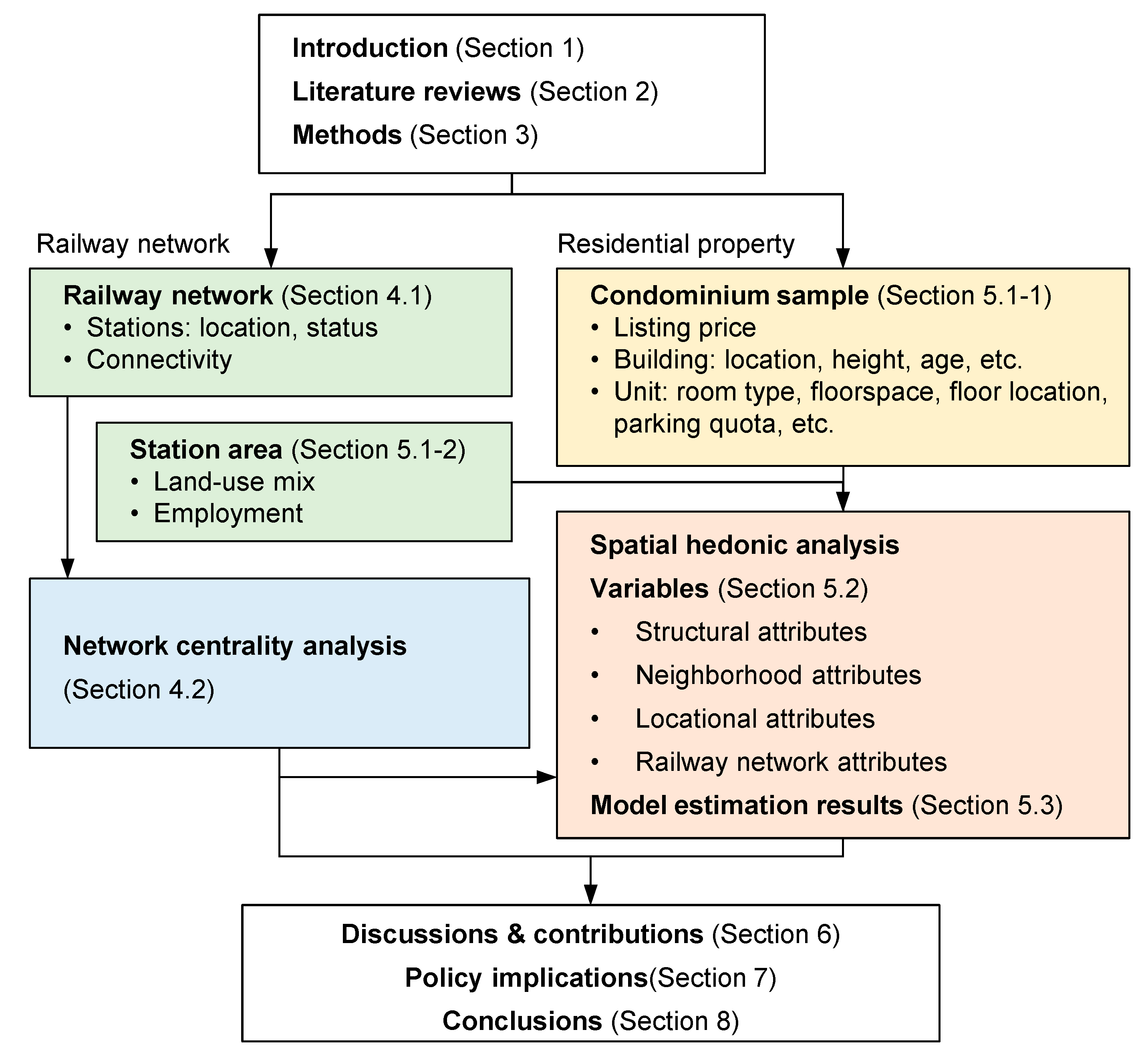

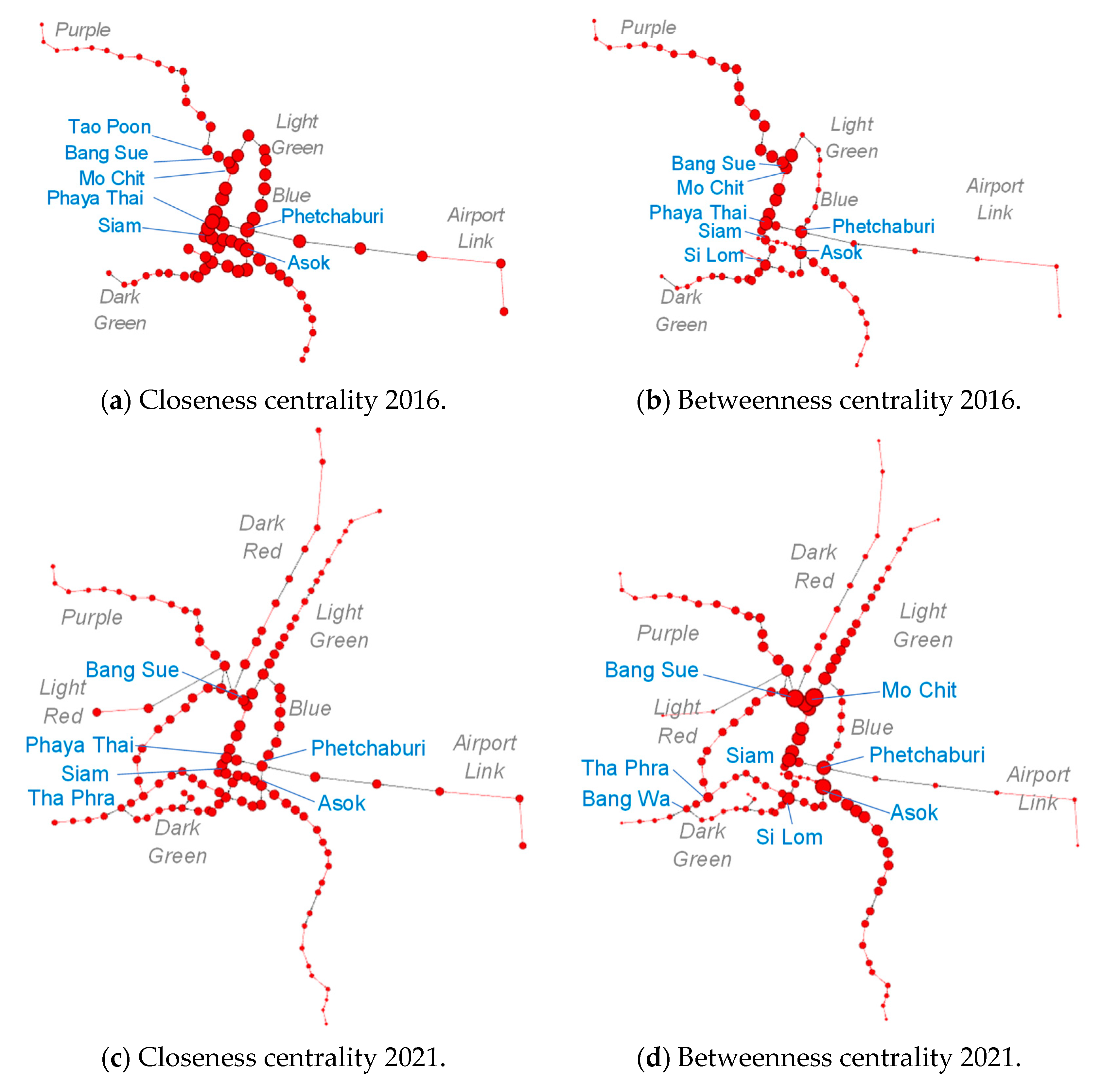
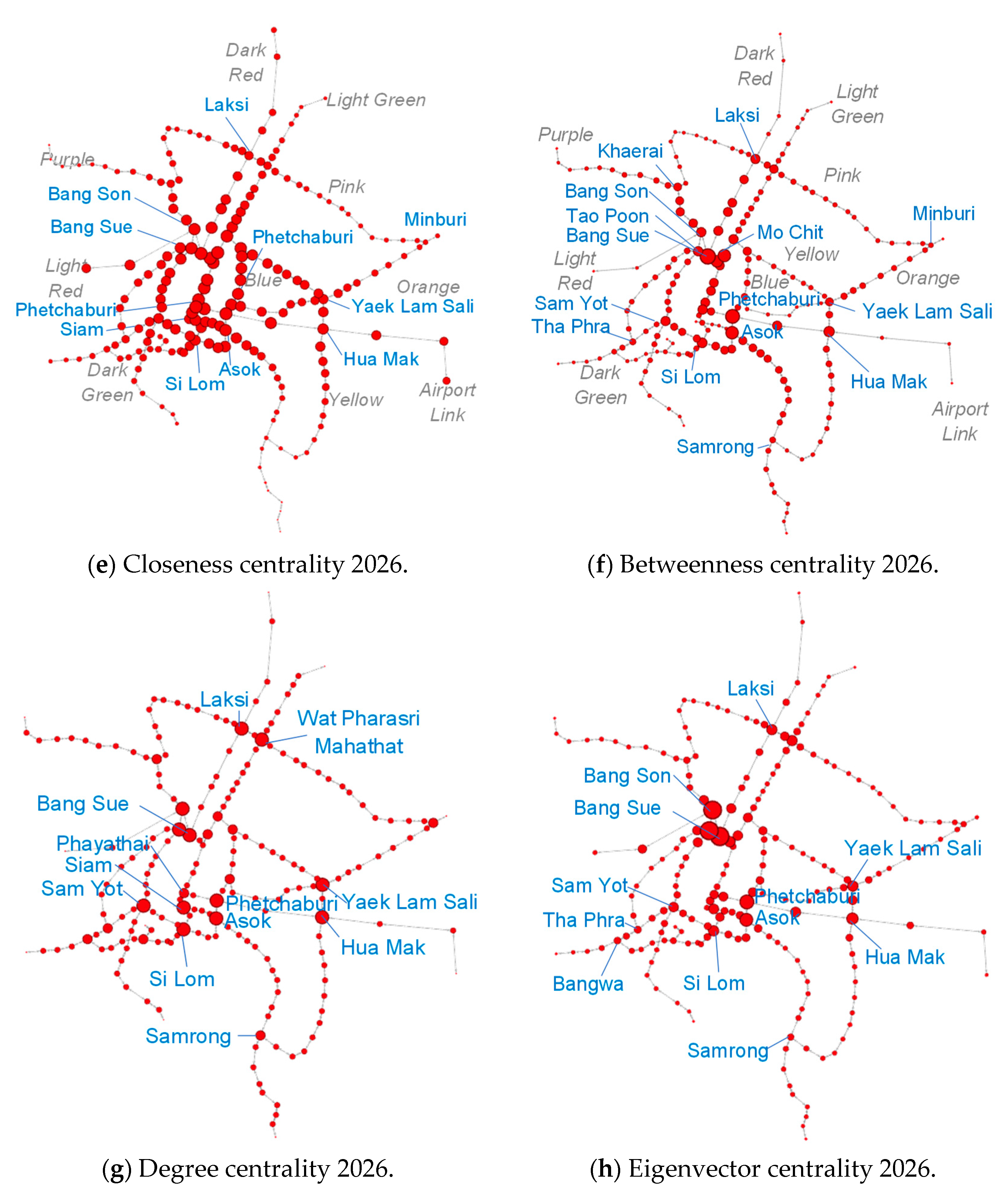
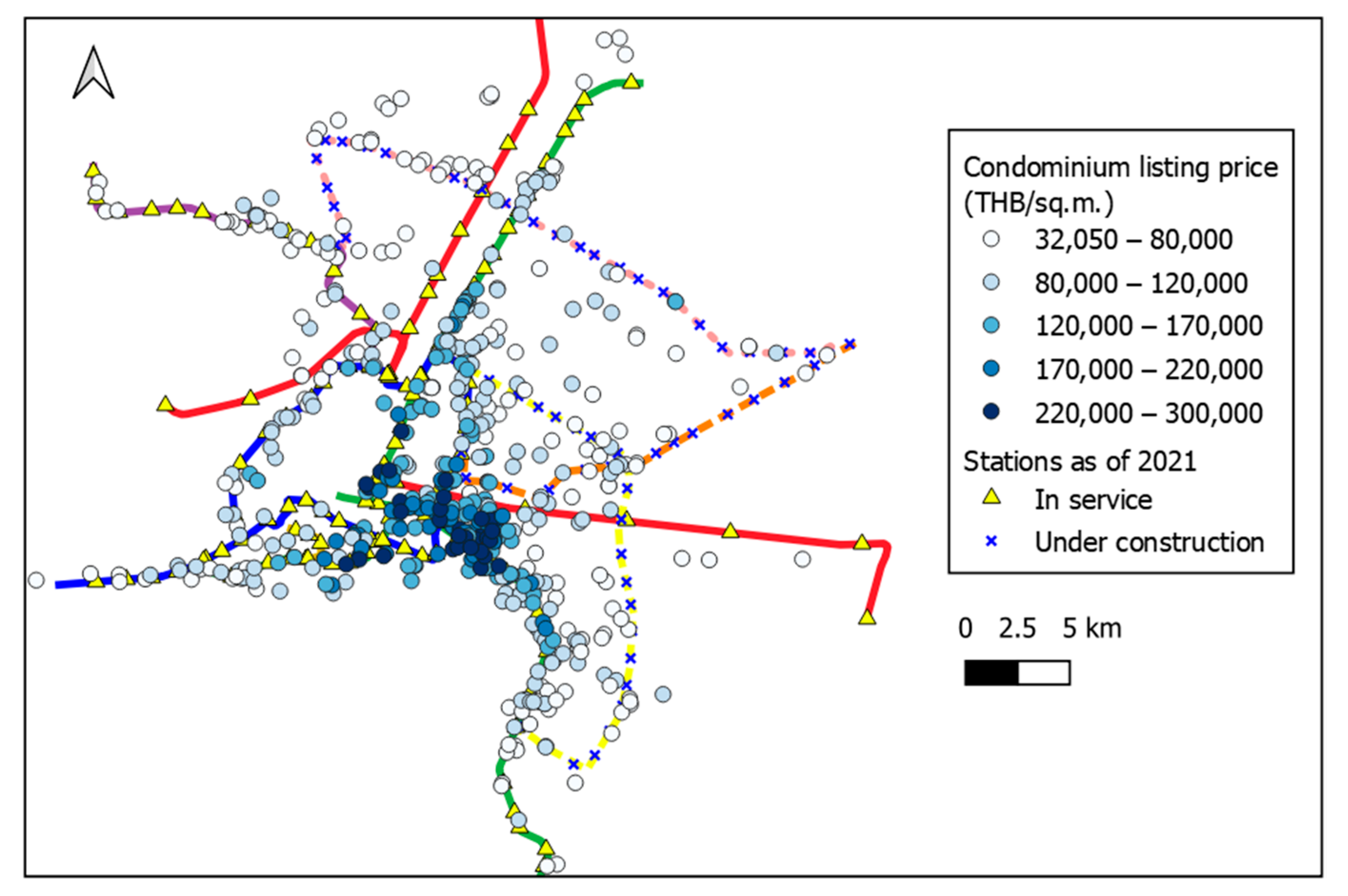
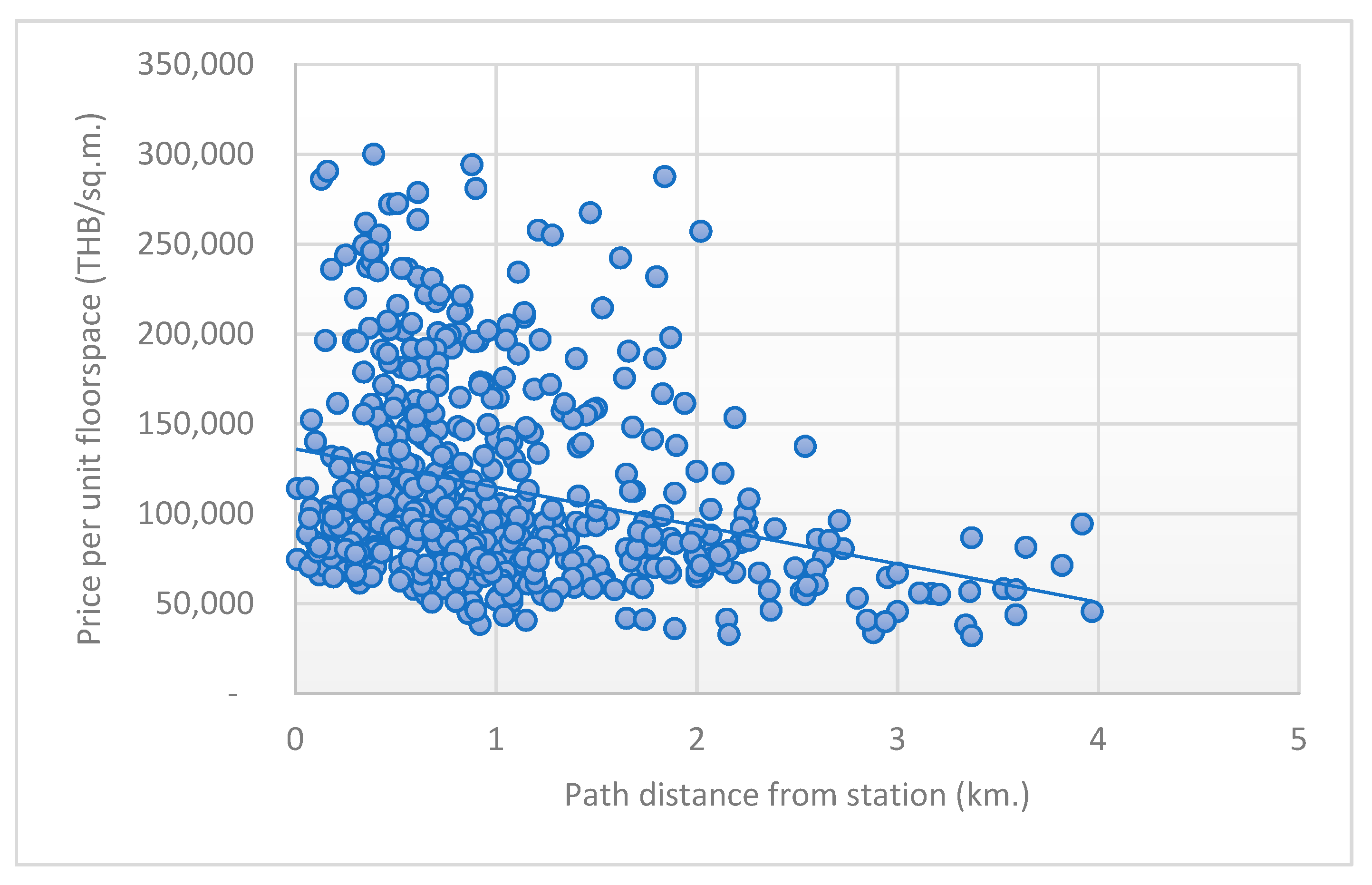
| Items (Unit) | Variables | Mean | std.dev. | min. | max. |
|---|---|---|---|---|---|
| Property value | |||||
| Listing price (Thai Baht) | - | 4,880,241 | 3,722,865 | 899,000 | 21,500,000 |
| Listing price per unit floorspace (Thai Baht per sq.m.) | PriceSqm | 113,199 | 56,752 | 32,050 | 300,0000 |
| Structural characteristics | |||||
| Floorspace of the unit (square meter) | Area | 40.81 | 18.53 | 21.70 | 224.00 |
| Age of the building (month) | Age | 25.11 | 28.20 | 0.05 | 248.00 |
| Category of the building (1 if high-rise, 0 otherwise) | HighRise | 0.49 | 0.50 | 0.00 | 1.00 |
| Neighborhood characteristics | |||||
| Land use mix index | LUM | 0.54 | 0.12 | 0.12 | 0.82 |
| Number of jobs around the station (persons) | Emp | 10,576.06 | 14,535.62 | 236.54 | 68,327.34 |
| Locational characteristics | |||||
| Euclidean distance to CBD: Siam Station (km.) | DistCBD | 9.57 | 5.20 | 0.77 | 26.38 |
| Euclidean distance to the nearest shopping mall (km.) | DistMall | 1.20 | 0.91 | 0.02 | 8.58 |
| Euclidean distance to the nearest hospital (km.) | DistHosp | 2.40 | 1.86 | 0.07 | 10.91 |
| Euclidean distance to the nearest university (km.) | DistUniv | 3.62 | 2.64 | 0.09 | 15.21 |
| Railway-related characteristics | |||||
| Proximity to the nearest station (Euclidean distance, km.) | - | 0.70 | 0.56 | 0.01 | 2.95 |
| Proximity to the nearest station (path distance, km.) | DistStn | 1.07 | 0.76 | 0.01 | 3.97 |
| Station status as of 2021 (1 if operational, 0 otherwise) | Open | 0.77 | 0.42 | 0.00 | 1.00 |
| Degree centrality of the nearest station in 2026 | CD | 4.25 | 0.91 | 2.00 | 8.00 |
| Closeness centrality of the nearest station in 2026 | CC | 0.070 | 0.013 | 0.038 | 0.091 |
| Betweenness centrality of the nearest station in 2026 | CB | 0.086 | 0.578 | 0.000 | 0.307 |
| Eigenvalue centrality of the nearest station in 2026 | CE | 0.126 | 0.121 | 0.010 | 0.978 |
| Variables | Model 1 OLS | Model 2 OLS, Degree | Model 3 OLS, Closeness | Model 4 OLS, Betweenness | Model 5 OLS, Eigenvector | |||||
|---|---|---|---|---|---|---|---|---|---|---|
| Coeff. | t-Value | Coeff. | t-Value | Coeff. | t-Value | Coeff. | t-Value | Coeff. | t-Value | |
| Constant | 140,017.00 | *** 17.85 | 131,341.00 | *** 15.50 | 109,412.00 | *** 11.13 | 122,169.00 | *** 14.03 | 131,341.00 | *** 15.50 |
| Highrise | 12,678.20 | *** 3.21 | 11,387.70 | *** 2.87 | 11,017.90 | *** 2.84 | 11,781.70 | *** 3.03 | 11,387.70 | *** 2.87 |
| Area | 388.21 | *** 3.51 | 383.53 | *** 3.48 | 337.76 | *** 3.11 | 349.07 | *** 3.20 | 383.53 | *** 3.48 |
| Age | −394.13 | *** −5.71 | −397.83 | *** −5.79 | −387.74 | *** −5.74 | −384.28 | *** −5.66 | −397.83 | *** −5.79 |
| Emp | 1.05 | *** 6.70 | 1.07 | *** 6.82 | 1.05 | *** 6.85 | 1.11 | *** 7.16 | 1.07 | *** 6.82 |
| DistCBD | −3455.70 | *** −6.91 | −2957.60 | *** −5.56 | −2067.45 | *** −3.68 | −2623.51 | *** −4.99 | −2957.60 | *** −5.56 |
| DistHosp | −4067.75 | *** −3.51 | −4126.14 | *** −3.58 | −4688.96 | *** −4.12 | −4018.04 | *** −3.53 | −4126.14 | *** −3.58 |
| DistStation | −7855.79 | *** −3.01 | −7511.80 | *** −2.89 | −6030.39 | ** −2.34 | −7009.28 | *** −2.73 | −7511.80 | *** −2.89 |
| Open × CD | 42,699.10 | *** 2.62 | ||||||||
| Open × CC | 357,805.00 | *** 4.97 | ||||||||
| Open × CB | 138,321.00 | *** 4.39 | ||||||||
| Open × CE | 42,699.10 | *** 2.62 | ||||||||
| Adj. R-squared | 0.519 | 0.525 | 0.541 | 0.536 | 0.525 | |||||
| AIC | 12,153.3 | 12,148.4 | 12,130.8 | 12,136.1 | 12,148.4 | |||||
| Variables | Model 6 Lag, Closeness | Model 7 Lag, Betweenness | Model 8 Error, Closeness | Model 9 Error, Betweenness | ||||
|---|---|---|---|---|---|---|---|---|
| Coeff. | z-Value | Coeff. | z-Value | Coeff. | z-Value | Coeff. | z-Value | |
| Constant | 1414.05 | 0.12 | 10,821.70 | 0.94 | 135,476.00 | *** 7.76 | 149,275.00 | *** 8.74 |
| Highrise | 13,464.30 | *** 4.01 | 14,066.10 | *** 4.18 | 15,630.20 | *** 4.65 | 16,194.30 | *** 4.81 |
| Area | 244.29 | *** 2.60 | 256.47 | *** 2.72 | 209.77 | ** 2.24 | 224.18 | ** 2.39 |
| Age | −340.43 | *** −5.83 | −339.72 | *** −5.78 | −316.10 | *** −5.47 | −324.72 | *** −5.60 |
| Emp | 0.49 | *** 3.70 | 0.51 | *** 3.81 | 0.45 | ** 2.54 | 0.46 | *** 2.61 |
| DistCBD | 1063.61 | ** 1.98 | 632.85 | 1.19 | −3408.93 | *** −2.69 | −4296.76 | *** −3.45 |
| DistHosp | −2439.31 | ** −2.42 | −2047.19 | ** −2.05 | −3764.51 | ** −2.21 | −2758.86 | * −1.66 |
| DistStation | −7422.11 | *** −3.33 | −8130.73 | *** −3.65 | −8151.90 | *** −3.49 | −8510.20 | *** −3.64 |
| Open × CC | 205,621.00 | *** 3.27 | 199,132.00 | ** 2.47 | ||||
| Open × CB | 56,372.60 | ** 2.07 | 26,776.40 | 0.85 | ||||
| 0.785 | *** 14.90 | 0.791 | *** 15.04 | |||||
| 0.834 | *** 17.24 | 0.844 | *** 18.22 | |||||
| R-squared | 0.656 | 0.652 | 0.660 | 0.657 | ||||
| AIC | 12,012.6 | 12,019.1 | 12,008.6 | 12,013.9 | ||||
Disclaimer/Publisher’s Note: The statements, opinions and data contained in all publications are solely those of the individual author(s) and contributor(s) and not of MDPI and/or the editor(s). MDPI and/or the editor(s) disclaim responsibility for any injury to people or property resulting from any ideas, methods, instructions or products referred to in the content. |
© 2023 by the authors. Licensee MDPI, Basel, Switzerland. This article is an open access article distributed under the terms and conditions of the Creative Commons Attribution (CC BY) license (https://creativecommons.org/licenses/by/4.0/).
Share and Cite
Vichiensan, V.; Wasuntarasook, V.; Prakayaphun, T.; Kii, M.; Hayashi, Y. Influence of Urban Railway Network Centrality on Residential Property Values in Bangkok. Sustainability 2023, 15, 16013. https://doi.org/10.3390/su152216013
Vichiensan V, Wasuntarasook V, Prakayaphun T, Kii M, Hayashi Y. Influence of Urban Railway Network Centrality on Residential Property Values in Bangkok. Sustainability. 2023; 15(22):16013. https://doi.org/10.3390/su152216013
Chicago/Turabian StyleVichiensan, Varameth, Vasinee Wasuntarasook, Titipakorn Prakayaphun, Masanobu Kii, and Yoshitsugu Hayashi. 2023. "Influence of Urban Railway Network Centrality on Residential Property Values in Bangkok" Sustainability 15, no. 22: 16013. https://doi.org/10.3390/su152216013





